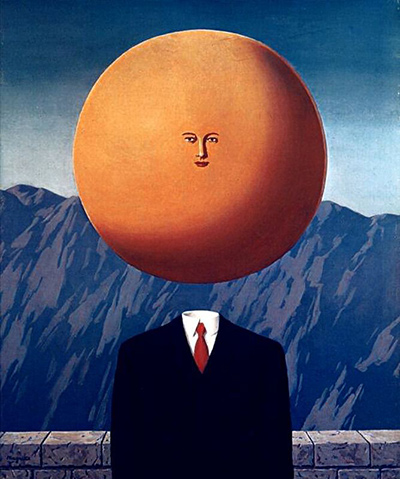The Art of Living is a 1967 surrealist painting by René Magritte. Like most surrealist paintings, it is hard to describe with any real accuracy, but it most closely resembles a portrait of a somewhat nondescript person.
This person is wearing a suit, but beyond that, all personal markers of identity have been stripped away.
The fact that this person is wearing a suit is not coincidental, as it helps to further obscure their individuality. Aside from the implication of involvement in the business world, a suit is one of the most generic apparel items out there and is a near-universal choice for special occasions in most of the world. Due to this, the person is easily perceived as being both everyone and no one all at once, driving home the universality of the ideas it espouses.
The person's most distinctive feature, however, its detached, hugely over-sized head. The way the head floats above the body, the contrast made by bright orange hue against the space-like expanse of blue, and the inconspicuousness of the small face placed in the middle of the head all create the impression that one is looking at a planet as much as they are is a person. This planetary focus, in combination with the title of the piece, suggests that a connection to the wider world around oneself is an important part of a fully-lived life. While each person is an individual, they are also part of a larger whole.
Another similar duality is reflected in the background of the piece. A low brick wall runs across the bottom of the portrait while large, impressive mountains loom above that segment. The wall functions as a symbol of man-made structure and order; it separates the person from the mountains and calls to mind the development of human civilization. The mountains, of course, represent civilizations' opposite: the untamed beauty of natural things. Despite the polar opposite connotations that both carry, both are also painted in similar soft blue tones, suggesting a kind of harmony between these elements as well as what they represent. Presumably, they are two equal opposite halves of the 'art' of life that the title posits, suggesting again that a holistic approach is the best (and perhaps only) way to live.




